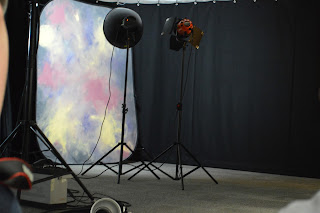Portrait photography
Portrait photography or portraiture is photography of a person or group of people that displays the expression, personality, and mood of the subject. Like other types of portraiture, the focus of the photograph is usually the person's face, although the entire body and the background or context may be included.
A face devoid of love or grace,A hateful, hard, successful face, A face with which a stoneWould feel as thoroughly at easeAs were they old acquaintances,-- First time together thrown.
-- "A Portrait" by Emily Dickinson
portraiture, the art of representing the physical or psychological likeness of a real or imaginary individual. The principal portrait media are painting, drawing, sculpture, and photography. From earliest times the portrait has been considered a means to immortality. Many cultures have attributed magical properties to the portrait: symbolization of the majesty or authority of the subject, substitution for a deceased individual's living presence or theft of the soul of the living subject.
The miniature portrait had retained its popularity with all social classes until the middle of the 19th cent., when it was replaced by the more intimate and more simply executed technique of photography. The earliest portrait photographers were thoroughly painterly in their approach, since they faced fierce competition from painters. Outstanding from the common run of the early portrait photographers were Matthew Brady, the team of Hill and Adamson, Julia Margaret Cameron, and Thomas Eakins.
The American pioneers of the aesthetic movement in photography in the early 20th cent. were Alfred Stieglitz and Edward Steichen, both noted for their luminous portrait studies. In Germany during the same period August Sander produced photographs that characterized the entire range of the German social classes. A number of American photographers working during the Great Depression produced a moving composite portrait of poverty-stricken rural America. These included, among others, Dorothea Lange, Walker Evans, Margaret Bourke-White, Russel Lee, Carl Mydans, Arthur Rothstein, John Vachon, and Ben Shahn. Other outstanding American portrait photographers of the 20th cent. include Edward Weston, Berenice Abbott, Immogen Cunningham, and Evelyn Hofer, whose work is reminiscent of August Sander's.
In 1955 the Museum of Modern Art, New York City, mounted a vast and influential exhibition of photographs entitled "The Family of Man." Selected by Steichen from hundreds of thousands of entries from all over the world, it presented a composite visual record, a profound portrait of the human family. Since then photographic portraiture has taken several new directions in the second half of the 20th cent.
Photographic self-portraits such as those of Man Ray and Duane Michaels also portrayed the sitter in a surreal setting. Nude portraits and multimedia works have proliferated, and the confrontation with the grotesque in human nature and physiognomy, masterfully explored by Diane Arbus, has spawned a number of imitators. Photographic portraits of the 1980s and 90s include works by such artists as Richard Avedon (who has taken masterly portraits since mid-century) and Annie Leibovitz. Moreover, the late 20th cent.'s cult of celebrity has spawned a host of anonymous "paparazzi," snapping spontaneous and often unflattering portraits of the celebrated and the infamous.
http://encyclopedia2.thefreedictionary.com/portraiture
we produced a series of images using different accessories in the studio.
For flash
using a softboxusing a softlight/beauty dish
a snoot
a honeycomb
a deep reflector
a umbrella
For constant source
using the close focus setting on a redhead
using the wide setting on a redhead
using a discharge tube light with deep reflector
 |
| Set up in studio |

















No comments:
Post a Comment